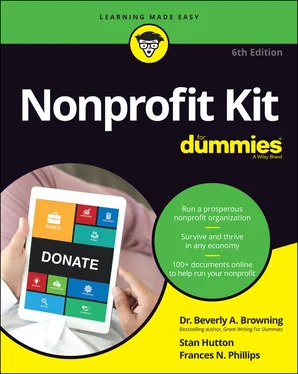 A board’s responsibilities are legal responsibilities. The three main duties that every board must uphold are care, loyalty, and obedience. Although they sound like vows one may take when entering a monastery, they actually describe established legal principles. Here’s what these duties entail:
A board’s responsibilities are legal responsibilities. The three main duties that every board must uphold are care, loyalty, and obedience. Although they sound like vows one may take when entering a monastery, they actually describe established legal principles. Here’s what these duties entail:
The duty of care: Refers to the responsibility to act as a prudent board member. In other words, board members must pay attention to what’s going on and make decisions based on information that’s available with reasonable investigation.
The duty of loyalty: Means that a board member must put the organization’s welfare above other interests when making decisions.
The duty of obedience: Requires that board members act in accordance with the nonprofit’s mission, goals, and bylaws.
 Basic information about board governance is available from BoardSource (
Basic information about board governance is available from BoardSource ( www.boardsource.org ) without charge. You can access more in-depth material by paying a membership fee.
Ex officio is a Latin phrase that means “by virtue of an office.” For example, if you had the necessary clout, you might have the mayor of your city sitting on your board as an ex officio member. When the current mayor leaves office, that person would be replaced by a successor. Sometimes, in practice, the term is confused with honorary or advisory by nonprofit organizations that want to honor someone or add a prominent name to their letterhead.
Secondary role: Dealing with planning, hiring, and other board tasks
In addition to the legal and fiduciary responsibilities, a nonprofit board performs other roles, including those described in the following sections.
Providing a guiding strategy
Every nonprofit should have an organizational plan, and every board should play a part in creating and maintaining that plan. Thus, an important role of any board is to guide the overall planning and strategy of its organization. At the most basic level, this job means regularly reviewing the organization’s mission statement and goals. Turn to Chapter 8for more information on planning.
Hiring and working with the executive director
A nonprofit board is expected to hire the organization’s executive director. Of course, many nonprofit organizations operate with no paid staff, but if your nonprofit does have employees, finding the right executive director is one of the board’s most important tasks. See Chapter 11for information about hiring paid employees.
A board works with its executive director to set goals and objectives for the year. Board members shouldn’t look over the director’s shoulder every day, but they should have a good idea of the director’s work plan and should ensure that her efforts are in line with the agency’s purpose.
Overseeing the organization’s finances
A board must make sure the organization has the resources to carry out its goals. As part of this duty, many boards are active in fundraising. But a board also is responsible for reviewing the organization’s budget and staying informed of the organization’s financial situation. Nothing is more dismal than finding out, for example, that an organization has been ignoring its payroll taxes, and could create personal liability for the directors (check out Chapter 7for more info about the board’s personal liability). A word to the wise: Insist on good financial reporting. At a minimum, have the board treasurer (or perhaps the executive director or bookkeeper, if you have one) prepare monthly financial reports and distribute them to your board for review.
ESTABLISHING AN ADVISORY BOARD
Some organizations form advisory boards, which have no governance responsibilities. Advisory boards are optional, and how they operate and relate to the governing board of directors varies widely among different nonprofit organizations. Generally, their role falls into one of the following two categories:
Members provide advice and guidance because of their professional expertise.
Prominent names are be listed on the organization’s letterhead.
We favor advisory boards that actually give advice (which generally means you have to ask for it) — even if they do so only once a year. Some organizations also use advisory board appointments as a way of getting to know potential board members.
 Many people join boards because they care about and understand the nature of the service that the organization provides, but they may not be trained in bookkeeping and accounting. These board members must try not to let their eyes glaze over when the financial report is reviewed at the board meeting, because part of a board member’s job is to understand finances. If members don’t understand the financial fine points, they need to ask questions of staff and other board members until they do understand them. Of course, they also can study Chapter 12on nonprofit budgets and financial statements.
Many people join boards because they care about and understand the nature of the service that the organization provides, but they may not be trained in bookkeeping and accounting. These board members must try not to let their eyes glaze over when the financial report is reviewed at the board meeting, because part of a board member’s job is to understand finances. If members don’t understand the financial fine points, they need to ask questions of staff and other board members until they do understand them. Of course, they also can study Chapter 12on nonprofit budgets and financial statements.
 Sometimes the problem is more than a lack of comprehension. For instance, the financial information may need to be presented more clearly. If one board member doesn’t understand the financial reports, chances are good that other board members don’t understand them, either. If your organization uses an outside accountant or bookkeeper to keep track of finances, ask for a brief meeting with that person to explain how they have presented the information. Many nonprofit service organizations offer affordable workshops on nonprofit finances and recordkeeping to assist board and staff members; others have programs that place volunteers from businesses into nonprofits.
Sometimes the problem is more than a lack of comprehension. For instance, the financial information may need to be presented more clearly. If one board member doesn’t understand the financial reports, chances are good that other board members don’t understand them, either. If your organization uses an outside accountant or bookkeeper to keep track of finances, ask for a brief meeting with that person to explain how they have presented the information. Many nonprofit service organizations offer affordable workshops on nonprofit finances and recordkeeping to assist board and staff members; others have programs that place volunteers from businesses into nonprofits.
Sharing responsibilities among the board, staff, and volunteers
Defining roles causes problems for a number of nonprofit organizations. Should the board of directors be involved in day-to-day management decisions? No, probably not. An executive director and their staff don’t need board members to approve every management decision that comes along. The board must trust the staff to run the organization. To put it simply, the board sets the overall goals and policies, and the staff implements them. But (and this is a big but ) many nonprofits have limited staff or even no staff. What happens when the organization’s work is done by the board and other volunteers?
In the case of volunteer-run organizations, board members must wear two hats. Most importantly, they must exercise their fiduciary responsibilities. When they meet as a board of directors, they must see the larger picture and make group decisions that benefit the organization and its programs and clients. But, at the same time, when they have to do the hands-on work needed to provide the services and perform the day-to-day tasks of running a nonprofit, board members must act as if they were employees or volunteer staff members. They may even hold regular, unpaid volunteer jobs with job descriptions and scheduled hours. Confusing, isn’t it? Still, anyone who serves as both a board member and a volunteer or staff member needs to keep this distinction in mind.
Читать дальше

 A board’s responsibilities are legal responsibilities. The three main duties that every board must uphold are care, loyalty, and obedience. Although they sound like vows one may take when entering a monastery, they actually describe established legal principles. Here’s what these duties entail:
A board’s responsibilities are legal responsibilities. The three main duties that every board must uphold are care, loyalty, and obedience. Although they sound like vows one may take when entering a monastery, they actually describe established legal principles. Here’s what these duties entail: Basic information about board governance is available from BoardSource (
Basic information about board governance is available from BoardSource (  Many people join boards because they care about and understand the nature of the service that the organization provides, but they may not be trained in bookkeeping and accounting. These board members must try not to let their eyes glaze over when the financial report is reviewed at the board meeting, because part of a board member’s job is to understand finances. If members don’t understand the financial fine points, they need to ask questions of staff and other board members until they do understand them. Of course, they also can study Chapter 12on nonprofit budgets and financial statements.
Many people join boards because they care about and understand the nature of the service that the organization provides, but they may not be trained in bookkeeping and accounting. These board members must try not to let their eyes glaze over when the financial report is reviewed at the board meeting, because part of a board member’s job is to understand finances. If members don’t understand the financial fine points, they need to ask questions of staff and other board members until they do understand them. Of course, they also can study Chapter 12on nonprofit budgets and financial statements.










